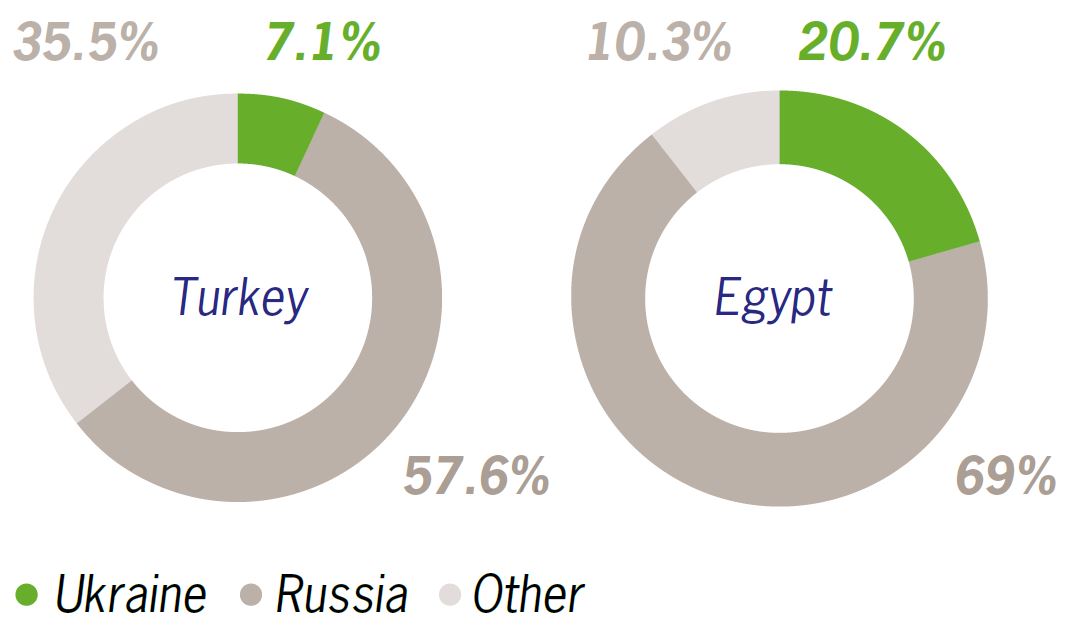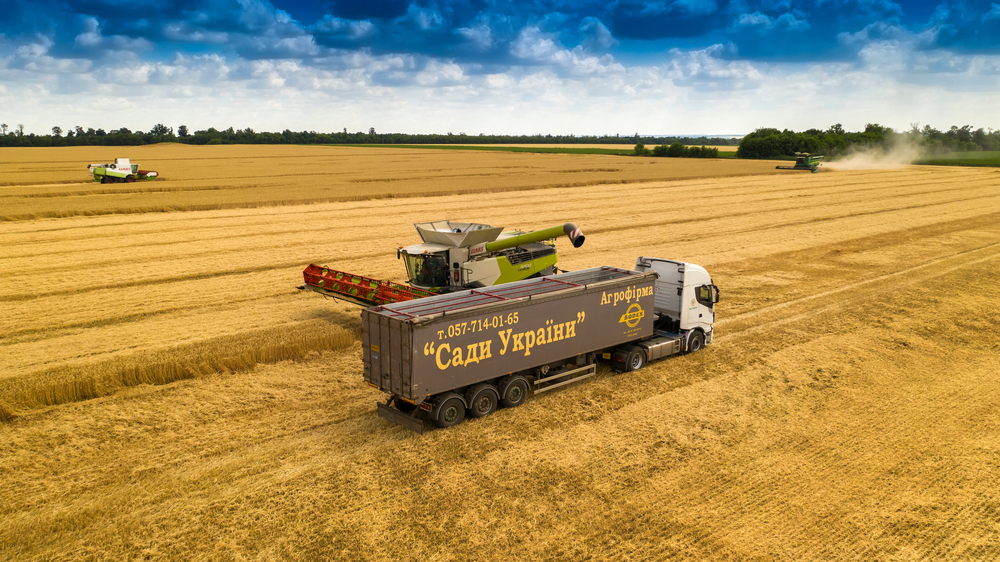
Wageningen World
Wheat is not scarce but expensive
The abrupt loss of cheap Ukrainian wheat rocked the world market, hitting poor consumers in Africa particularly hard. And wheat will remain expensive for a while yet, economists from Wageningen fear. Not because of scarcity, but because of the sharp increase in the price of fertilizers. ‘Perhaps it is time to rethink the far-reaching liberalization of markets.’
Photo above: Chris McGrath / Getty Images
Kees Huizinga, a Dutch farmer in the Ukraine, has been a frequent guest on talk shows, where he has expressed his concern about the impact of the war on the food supply. The country is often described as a ‘breadbasket’, and yet Ukraine’s share of the world wheat market is limited, says economist Petra Berkhout of Wageningen Economic Research. ‘Things like weather conditions cause annual fluctuations in global wheat production, and in some years these fluctuations are much bigger than the Ukrainian yield. So this is not about the availability of wheat, but its affordability.’ The high price of wheat has particularly serious consequences for countries in the Middle East and North Africa that normally source most of their wheat from Russia and Ukraine.
Ukraine has very fertile soil and low fertilizer and energy prices, enabling it to produce the cheapest wheat in the world, most of which is destined for export. ‘This makes it possible to supply the urban population in Africa with cheap wheat,’ explains Bart de Steenhuijsen Piters, who also works at Wageningen Economic Research. ‘Several African countries have become addicted to it. These include countries such as Ethiopia and Tanzania, which can grow wheat or other grains themselves. It’s just that their own grain is more expensive.’ Most of the concern is focused on wheat, and yet Ukrainian exports of sunflower oil and maize are hampered too. According to the researchers, this does not have a major impact on food security in the Netherlands because there are enough alternatives available for both crops. Other oils such as rapeseed oil are an adequate substitute for sunflower oil. Maize is mainly used as cattle feed and can be replaced by soya, among other things.
More expensive bread
Egypt and Turkey are the most dependent on Ukrainian wheat, which is normally transported via the Black Sea. Turkey has been facing high food prices for a while, partly due to the fall of the lira, the national currency. And now the price of bread has risen even further. In Egypt, where bread is heavily subsidized and rationed by the state, the search is on for alternatives to Ukrainian wheat. The country placed a large order for wheat from France, for example, and wheat flour is being mixed with starch from sweet potatoes. But according to De Steenhuijsen Piters, a much more worrying situation is currently developing in the Horn of Africa, where extreme drought has caused crop failures. ‘The United Nations World Food Programme is distributing wheat, but the high prices mean that the aid organizations can only buy half what they would normally. Emergency aid has become too expensive,’ explains De Steenhuijsen Piters.

He describes the plight of African city dwellers as less acute, but just as dire, as they often spend more than 60 per cent of their income on food. This makes city dwellers extremely vulnerable to price increases, says De Steenhuijsen Piters. He helped with the analysis for a study among 26,000 urban households in Benin. ‘If you look at their food situation, you get quite a shock. Local food prices fluctuate with the international markets. As soon as food prices go up, there is no money left for school or clothes.’ Like Berkhout, he does not talk in terms of a food shortage, but of a lack of purchasing power which makes food too expensive for the poorest. Over the past decade, average global food prices actually fell, but the onset of the Covid-19 pandemic was a turning point, after which prices rose rapidly. The virus made trade more difficult and energy prices, which are a big factor in fertilizer prices too, rose. The war in Ukraine came on top of that, Berkhout says. ‘Normally, as an economist, I would say that a high price stimulates an increase in production, which then leads to a fall in prices. Now I am doubtful because of the increased prices of fertilizer and energy, which are a big factor in the price of food. There are a lot of uncertainties and no one knows how long this conflict will last.’
Creating scarcity
In particular, the price of fertilizer may remain high for a long time, with consequences more far-reaching than the loss of Ukrainian wheat. An important component of fertilizer is potash, which is mainly mined in Russia and Belarus. Both these countries could create a lasting scarcity. High prices wouldn’t stop farmers in Europe from spreading fertilizer, but it’s a different matter in Africa, says Berkhout. ‘Farmers there have fewer liquid assets, so they tell us they are going to use less fertilizer.’ If African farmers use less fertilizer, their yields will lag behind and they will become even more dependent on food grown abroad, say the two scientists. De Steenhuijsen Piters sees the war in Ukraine as exposing the way a free world market jeopardizes food security. ‘The cheapest food of all goes to the poorest consumers. Their wheat is sourced from the Ukraine, but in West Africa they also eat chicken wings from the EU. That can work well for a long time, until something happens to disrupt the system.’

Local production
The way to reduce vulnerability to disruption, according to De Steenhuijsen Piters, is to diversify food sources, getting some wheat and other food crops from the region and some from various countries further away. Wheat, for example, can also be sourced from Canada, albeit at a slightly higher cost. Increasing local production is also key to increasing food security, says De Steenhuijsen Piters. Powerful instruments for this, in his view, are subsidizing fertilizers and fuel, and imposing an import tax on wheat. Even if, say, yields in Africa are successfully boosted through fertilizer subsidies, it is by no means a foregone conclusion that farmers will then produce more wheat. Whereas food production is highly regulated in Europe, in Africa more than 80 per cent of all food is traded through informal businesses, he explains. ‘So governments have very limited control over what is produced. There is no point in a government deciding to give a tax break on wheat, because most businesses don’t pay any sales tax.’
It is generally traders who decide which crops farmers will sow. They do not see food security as their task and they go for the most lucrative crops. These might be cash crops like cotton or cocoa, which do not contribute to greater selfsufficiency. To get a better grip on food production, says De Steenhuijsen Piters, it is important to gain a real understanding of the informal economy. So he and his local partners - mostly Wageningen alumni – are going to talk to informal traders. The researchers hope these interviews will give them an insight into the traders’ network and the considerations at play in in their decision-making. De Steenhuijsen Piters: ‘We always think in terms of formal measures such as tax benefits, but we are now increasingly realizing that our conventional tools are not working. It’s important to recognize that and to get round the table with traders. Just ask the question: what would it take for you to target other objectives, such as food security?’
Becoming self-sufficient
Even if they increase local wheat production, self-sufficiency is not feasible for many countries, Berkhout says. Political instability gets in the way, but in numerous countries it is technically impossible too: ‘Egypt, for example, couldn’t do it because it has too little agricultural land. And lots of countries can switch to local grain varieties such as sorghum or millet, but these grains can’t compete with cheap and efficiently produced wheat from elsewhere.’

Now that the market has recovered from the initial panic after the war broke out, wheat prices have dropped from a peak of 66 per cent above pre-war levels last summer to 20 per cent above prewar prices. Both researchers believe that other countries will increase their wheat production next year, which will normalize the price. But they do expect that the high energy and fertilizer prices, along with the impact of the serious droughts now affecting several regions, will keep food prices in general high for the coming years. According to De Steenhuijsen Piters, the short-term solution is simple: more money must be allocated to emergency aid so that more food can be distributed in regions suffering from severe drought. In areas where local stakeholders are in trouble because of high food prices, he says, the most effective approach is to provide financial support in the form of cash transfers for vulnerable households. In the longer term, he argues for sourcing food more diversely and stimulating local food production. ‘This requires forms of subsidy or even import levies so producers can compete with imported food. And that is controversial because it goes against the principles of free trade. Perhaps it is time to rethink the far-reaching liberalization of markets’.
Food, feed or fuel
Berkhout points out that food crops are currently also used for cattle feed and biofuel. In the EU, for example, two-thirds of the grain grown, including maize, is used for livestock feed: ‘If food becomes so expensive, you have to consider whether to grow crops for food, feed or fuel.’ De Steenhuijsen Piters hopes the war will rekindle the debate on international food markets and food security in Africa. He sees the National Food Dialogues, held worldwide in the run-up to the first UN Food Systems Summit in 2021, as a good start. ‘Until now, there has been too much emphasis on cheap calories. Food security and food diversity are equally important yardsticks. We need to go on talking to all the important stakeholders. I think the war has increased the support base for that discussion.’